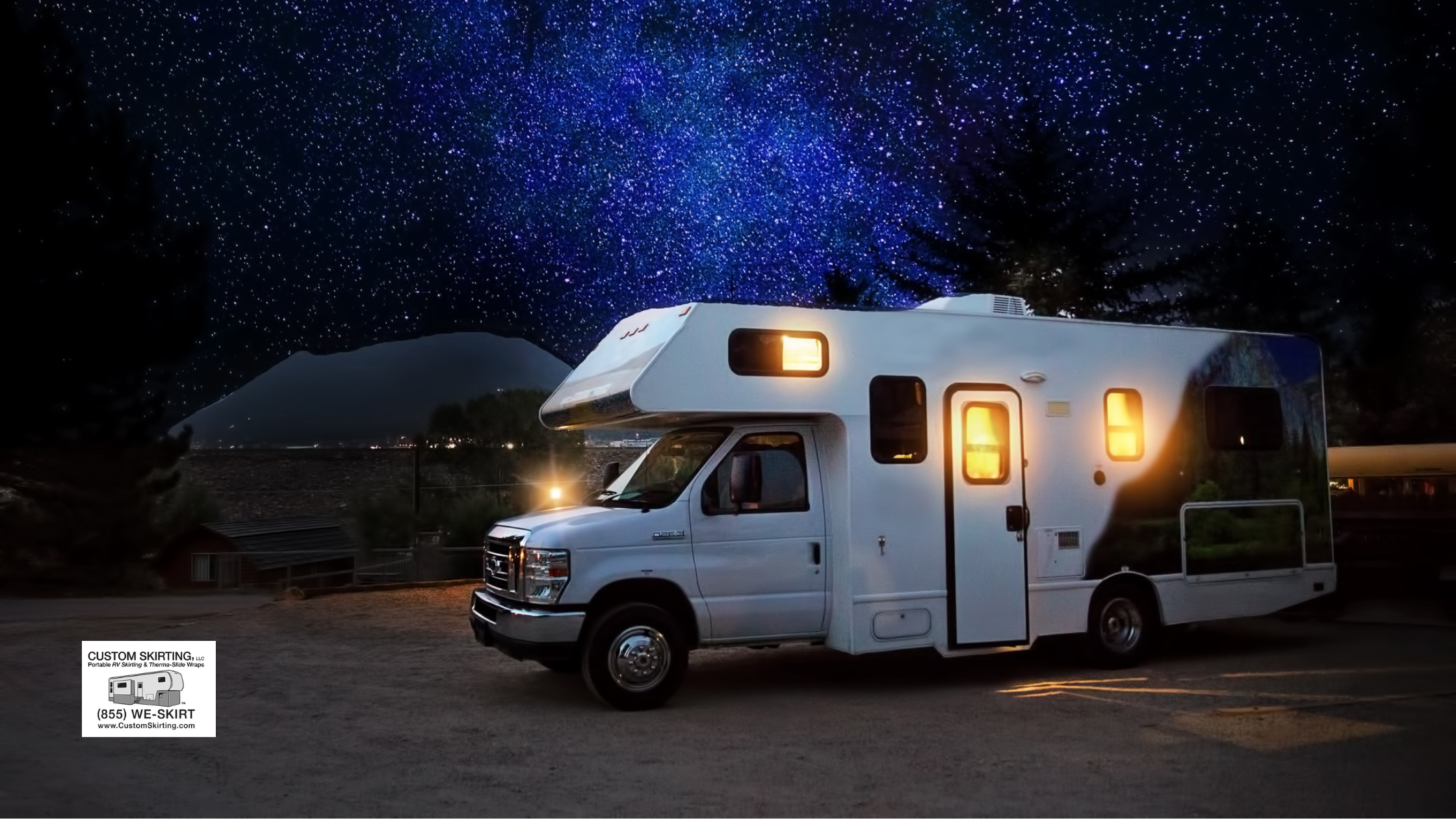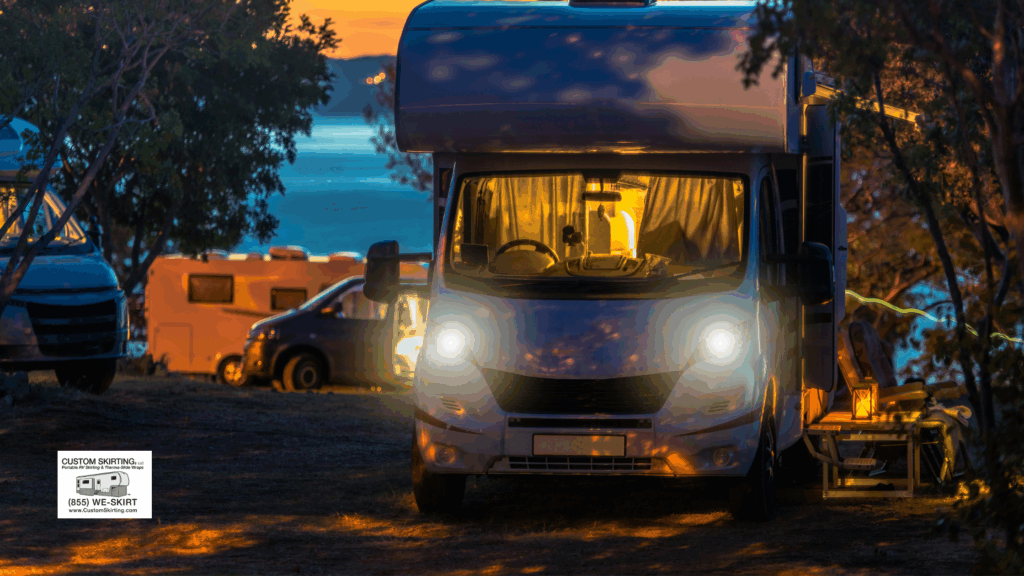
How Do RVs Get Power? A Guide to RV Electrical Systems
Table of contents
- Understanding RV Electrical Systems Basics
- Primary RV Power Sources
- Essential RV Power Components
- Power Management Strategies for Different RV Situations
- Troubleshooting Common RV Power Issues
- Upgrading Your RV’s Electrical System
- Power Up & Seal In Comfort: Custom Skirting for Smarter RV Living
- Related Articles
Understanding how do RVs get power is essential for every RV owner, whether you’re a weekend traveler or a full-time RVer. One of the most common questions new RVers ask is: how do RVs have electricity when they’re far from home or parked off-grid? The answer lies in the complexity of RV power systems, which utilize multiple sources to provide electricity for everything from lighting and climate control to cooking and charging devices. This guide explains how do campers get power, covering everything from the basics of RV power connection to advanced topics like solar energy, lithium batteries, and smart power management. We’ll explore the AC and DC systems that work together inside your RV, troubleshoot common electrical problems, and provide practical strategies for managing your power in a variety of camping conditions, including desert heat and winter snow.
Understanding RV Electrical Systems Basics
AC vs. DC Power in RVs
RV electrical systems operate on two primary types of electricity: Alternating Current (AC) and Direct Current (DC).
- AC Power (120V): Similar to what you have at home, AC power runs appliances like microwaves, air conditioners, and TVs. This power is usually available through campground hookups (shore power) or a generator.
- DC Power (12V): This runs lights, fans, water pumps, and RV control panels. DC power is supplied by the house batteries and is always available unless the batteries are depleted.
Most RVs are wired to use both AC and DC power simultaneously. If you’ve ever wondered how do campers get power, the answer lies in the RV distribution panel, which includes circuit breakers for AC systems and fuses for DC systems—protecting your equipment from overload or short circuits.
RV Power Consumption Basics
Power consumption in RVs is measured in amps. Each appliance or device draws a certain number of amps when in use. For example:
- Air conditioner: 12-15 amps
- Microwave: 8-10 amps
- Coffee maker: 6-8 amps
- Water pump: 4 amps
- LED light: 0.5 amp
To calculate your total power needs, multiply the amps by the number of appliances you’ll use at once. Understanding how do campers get power is essential—most RVs can’t support multiple high-draw appliances running simultaneously, so managing your usage is key.
Primary RV Power Sources

Shore Power (Campground Hookups)
One of the most common RV power connection sources is shore power, typically found at RV parks and campgrounds.
- 30-amp service: Common in smaller RVs; delivers up to 3,600 watts.
- 50-amp service: Provides up to 12,000 watts and is ideal for larger RVs with multiple AC units.
To safely connect to shore power:
- Turn off the RV’s main breaker.
- Plug into the pedestal using the correct cable.
- Use a surge protector to protect against voltage spikes.
Common issues with shore power include low voltage and tripped breakers. Always check the campground’s power rating and use voltage monitoring tools to avoid damaging your system.
RV Generators
Generators are essential for how do RVs get power when shore power isn’t available. They provide AC power and also charge the house batteries.
Types of RV generators:
- Built-in: Found in motorhomes.
- Portable: Used for travel trailers.
Fuel types include:
- Gasoline: Common but noisy.
- Diesel: More efficient, used in Class A RVs.
- Propane: Cleaner but shorter runtime.
Choose a generator based on wattage needs. A 3,000-watt unit may power an AC and microwave, but running multiple devices requires more capacity. Regular maintenance includes oil changes, checking fuel levels, and cleaning filters.
House Batteries and DC Power
How do campers get power when they’re off-grid? House batteries supply 12V DC power and are crucial for boondocking.
Battery types:
- Flooded Lead-Acid: Affordable but require regular maintenance.
- AGM: Maintenance-free but more expensive.
- Lithium (LiFePO4): Lightweight, longer lifespan, fast charging, performs well in heat and cold.
Monitoring and maintaining your batteries is essential, especially in extreme weather. In winter, keep lithium batteries warm with heat pads or insulation. In summer, prevent overheating by ensuring airflow.
Solar Power for RVs
Solar energy is a popular option for RVers who want sustainable, quiet, and cost-effective power. It’s an excellent answer to how do RVs get power off-grid.
Components:
- Solar Panels: Mounted on the roof or portable.
- Charge Controller: Regulates power from the panels to the batteries.
- Battery Bank: Stores the power.
- Inverter: Converts DC to AC power.
A 200W panel setup can run lights and charge devices. To run an air conditioner, you’ll need a large solar array and battery bank. Solar works best in sunny areas like the desert but may underperform in forested or overcast regions.
Essential RV Power Components
Power Converters and Inverters
Converters and inverters are key to integrating different power sources into your RV system.
- Converter: Turns incoming AC power into DC power to charge batteries and run 12V systems.
- Inverter: Converts DC power from batteries into AC power for appliances.
Inverters come in two types:
- Modified Sine Wave: Cheaper but less compatible with sensitive electronics.
- Pure Sine Wave: More expensive but required for most modern devices.
Transfer Switches and Power Distribution
A transfer switch ensures safe transitions between shore power and generators, automatically selecting the available source and preventing overload.
Your distribution panel sends power to outlets, lights, and appliances. Regular checks of circuit breakers and fuses prevent problems like short circuits or equipment damage.
Surge Protectors and Power Management Systems
Protect your RV with:
- Surge Protectors: Basic protection against voltage spikes.
- EMS (Electrical Management Systems): Advanced protection against low voltage, open ground, reverse polarity, and surges.
Choose between portable units or hardwired systems. EMS devices are especially important in older campgrounds where voltage inconsistencies are more common.
Power Management Strategies for Different RV Situations

Campground Power Management
Even with hookups, managing your power wisely is essential:
- Avoid using high-draw appliances at the same time.
- Monitor amperage draw with a power meter.
- Adapt to 20A or 15A service with proper converters and reduce consumption.
In hot climates, stagger AC usage. In cold climates, prioritize electric heaters only if you have 50A service.
Boondocking and Off-Grid Power Strategies
Boondocking requires careful planning:
- Use LED lights.
- Limit inverter use to essentials.
- Charge devices during peak solar hours.
- Run the generator during allowed hours to recharge batteries.
In desert camping, solar works great. In forest camping, rely more on generators and battery banks due to limited sun exposure.
Troubleshooting Common RV Power Issues
Common problems and solutions:
- No Power in RV: Check main breaker, shore connection, or battery charge.
- Flickering Lights: Possible low battery or failing converter.
- AC Not Running: Check circuit breaker, thermostat, or shore power amperage.
Basic troubleshooting steps:
- Check all breakers and fuses.
- Test voltage at power pedestal.
- Inspect power cords for damage.
- Check battery voltage and connections.
Regular preventive maintenance includes inspecting cords, tightening battery terminals, and cleaning vents and panels—essential steps in ensuring how RVs have electricity safely and efficiently.
Upgrading Your RV’s Electrical System
Common upgrades:
- Add Lithium Batteries: More efficient, ideal for off-grid living.
- Install Larger Inverter: Run more devices from battery power.
- Expand Solar Array: Increase renewable energy collection.
- Smart Power Monitors: Track energy use, battery status, and system performance remotely.
Smart systems like Victron or GoPower offer real-time insights, making energy management much easier. These upgrades are great for full-timers or those camping in remote areas.
So, how do RVs get power? Through a blend of shore power, generators, batteries, and solar systems—each with unique advantages depending on your travel style. Whether you’re wondering how do RVs have electricity off-grid or looking to improve your RV power systems with modern upgrades, understanding these components is crucial.
Now that you know how do campers get power, you can travel more confidently, avoid common power issues, and even camp comfortably in extreme environments. And with a reliable RV power connection, you’ll always be ready to hit the road—powered up and prepared.
Power Up & Seal In Comfort: Custom Skirting for Smarter RV Living
Now that you understand how RVs get their power—and how campers get power too—why not take it a step further and make your electrical system even more efficient? Custom skirting is a game-changer for energy-conscious RV owners—it insulates your rig, protects it from the elements, and helps your power systems work smarter, not harder.
At Black Hawk Creek, we partner with the nation’s #1 RV skirting solution, offering on-site blueprinting and custom fitting with our exclusive No-Snap, No-Gap channel system. Rain, snow, and wind don’t stand a chance—and neither does energy waste. Our proven design has stood strong in the toughest climates across the U.S. and Canada.
Don’t just power your RV—protect it.
Explore Custom Skirting Options Today and Upgrade Your RV’s Performance
